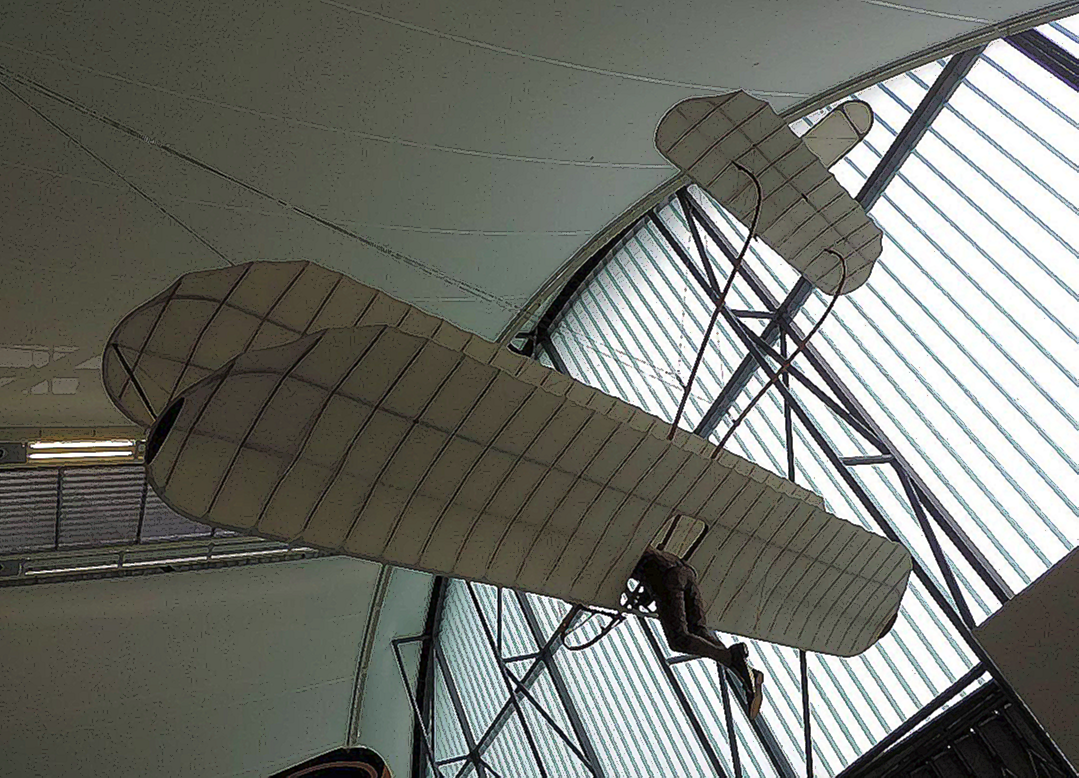


Clarke Glinder Hendon
English Translation
 |
Historique Voir ICI
History Click HERE
In 1910 TWK Clarke and Co., a Kingston-on-Thames manufacturer of aircraft, accessories and flying models, produced a range of four biplane gliders. This machine, based on a configuration evolved by the American pioneer Octave Chanute, was the third largest of the range and resembled the Wright brothers' aircraft in general construction. It could be bought as a kit for 10 guineas (£10.50) or completely assembled and covered for £34.The machine was flown as a hang-glider with the pilot resting his armpits on the padded cushions, while the two control levers, connected in unison, operated the rudder when moved from side to side and the one-piece elevator when moved backwards or forwards. Banking in turns was achieved by the pilot swinging his body and legs towards the inside of the anticipated turn. Gliding and hang-gliding are now popular leisure pastimes, but at the time T.W.K. Clarke built this glider, powered and controlled flight had yet take place. Gliders were used by many pioneers to perfect their skill at flying and also the machines they were building.
What makes this a milestone aircraft?As a representative of the earliest gliders, this type of machine was the "test bed" for what we now enjoy as powered and controlled flight. The first aircraft to fly was, in fact, an identical configuration to a glider with an engine fitted.
CLARKE CHANUTE GLIDER ‘BAPC.100’
MUSEUM ACCESSION NUMBER 1994/1346/A
1910
Built by T.W.K. Clarke & Co, Aeronautical Engineers, Kingston on Thames, Surrey for the Royal Aero Club as a biplane glider.T.W.K stood for Thomas Wigston Kingslake. Clarke & Co produced a range of four biplane gliders, including the ‘Chanute’ of which this is an example, priced at £34 complete.Based on the gliders produced by American pioneer Octave Chanute and illustrated in ‘The Aero’ Feb 1913. Jan -Feb 1913 One of three gliders (including those of Percy Pilcher and Lilienthal) displayed at the Science Museum, South Kensington as part of a special aeronautical exhibition. Science Museum inventory number 1914/37.On loan from the Royal Aero Club.
1913 -61
Displayed in South Kensington western Galleries at this time except during the two world wars, with the fabric completely stripped from the lower wing to show the construction. The tailplane may have been recovered around 1944 prior to post - war redisplay.
c.1961
To Science Museum store at Hayes, Middx when the Western Galleries at South Kensington were cleared prior to redisplay.
12 Jan 81 From Science Museum store at Hayes to RAF Museum Reserve Collection and Restoration Centre, Cardington, Beds for restoration.
1982/3
Completely dismantled, and reassembled with a new cover for the top plane, the original being stored at Cardington and later at Stafford and Wyton. Accession number 84/A/732 for 31x42 inch fragment retained.
Late 1983
To RAF Museum Hendon for suspended display in main aircraft hall, on permanent loan from the Royal Aero Club through the Science Museum.
Feb 2001
Removed from display due to Museum building work; stored on site pending work on water damaged upper wing covering.
27 Feb 01
To temporary restoration facility at RAF Wyton for recovering.
7 Nov 01
Returned to RAFM Hendon for display following complete recovering with undoped linen.
28 May 03
Moved to new Milestones building at Hendon for continued suspended display